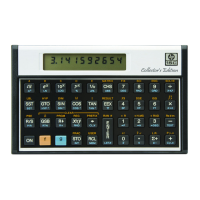216 Appendix C: Memory Allocation
1. Place dd, the number of the highest data storage register you want
allocated, into the display. 1 ≤ dd ≤ 97. The number of registers in
the uncommitted pool (and therefore potentially available for
programming) will be (97 − dd).
2. Press ´ m %.
There are two ways to review your allocation:
Press l m % to recall into the stack the number of the
highest-allocated data storage register, dd. (Programmable.)
Press | W (as explained above) to view a more complete
memory status (dd uu pp−b).
(assuming a cleared program memory)
*
1 ´ m %
1.0000
R
1
, R
0
, and R
I
allocated for data storage.
Ninety-six registers are
uncommitted; none contain
program instructions.
| W (hold)
01 96 00-0
19 ´ m %
19.0000
R
19
(R
.9
) is the highest-
numbered data storage
register. Seventy-eight
registers left in the
common pool.
l
m
%
19.0000
Restrictions on Reallocation
Continuous Memory will maintain the configuration you allocate until a
new m % is executed or Continuous Memory is reset. If you try to
allocate a number less than 1, dd = 1. If you try to allocate a number
greater than 97,
Error 10
results.
*
If program memory is not cleared, the number of uncommitted registers (uu) is less,
owing to allocation of registers to program memory (pp). Therefore, pp would be > 0 and
b would vary.

